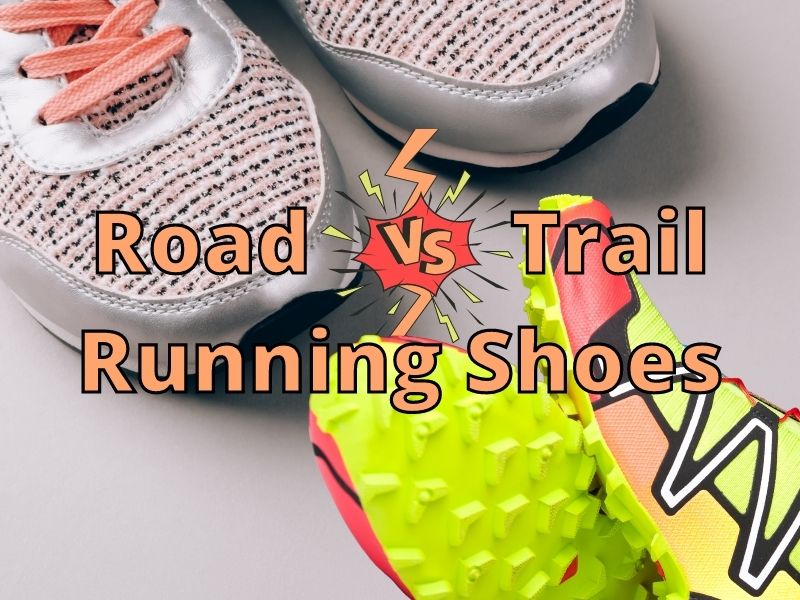If you’re into running or hiking, you know that there are different types of shoes to choose from. Some people like to use trail runners for hiking and some people use running shoes on trails. You can find a wide range of shoes that function fine in different environments, so which ones should you get.
If you have the funds get both road running shoes and trail running shoes. If I could only choose one, I would choose a trail runner if my time on and off the road is fairly equal and a road running shoe if I spend 80% or more time on the road.
It can still be confusing because there are so many variations of shoes. With so many options to choose from, many people find themselves asking that same question, “Which shoe should I get?”
The days an all-in-one sports shoes are gone. Today we have very specialized shoes that are made to meet the needs of more specific groups of people.
We do still have sneakers, but these shoes aren’t specifically meant for running. We need to think about the terrains, weather, and climate we run in to get the best idea of the shoe we need.
Some people claim that trail runners work great for running on the street as well. Each is different, so you’ll need to consider the tread, cushioning, and stability of the shoe if you’re looking at a shoe that can work on and off the streets.
I have been on several dirt trails that were mostly flat using regular road running shoes and they worked just fine. But most of the time I run on the road.
If the weight of the shoe is a concern many trail runners are around 10-11 oz. which is not much higher than many road running shoes.
Lastly, I would consider the durability of the shoe. Some trail runners have a softer grippy tread that might wear down quicker on the street. They may also have weatherproofing or protections that road shoes don’t have.
Also, some shoes use EVA, PU, or a mixture of higher and lower-density foams. A denser foam will last longer but not cushion as much.
There’s a lot to think about, but I think it comes down to your preference and the shoe’s function.
We’ll discuss the differences between trail runners and running shoes, as well as whether it’s worth you buying a pair of each, or just using one pair for both activities.
What Are Trail Runners?
AD
There are many different types and styles of trail runners. Some resemble more of a road running shoe, while others are more like a hiking shoe. They tend to have fairly knobby tread and a more rugged toe cap and upper.
They’re tougher so they can be hardwearing and used in different terrains, temperatures, and environments. When it comes to trail runners, they’re designed in a way to tackle dirt, hills, rocks, and vegetation without slipping, much like a hiking boot.
And similar to a road runner, trail runners have a flexible sole to make running easier. Yet, trail runners, in general, have a stiffer mid-sole.
Some trail runners get hotter and have less breathability. This is due to the fact they are sometimes splash-proof or waterproof. So using them in colder weather would be best, or wet weather.
Trail runners should have a less heel-to-toe drop to help with the varying terrain.
Trial runners could be considered a hybrid between hiking boots and running shoes, more are very close to road running shoes. They’re capable shoes for off-road and depending on the shoe you get, they can be used on the road as well.
They weigh just a bit more than your average running shoe.
The general rule is trail runners are more ideal for trails, and if you use it on the street, be aware that it might not work for you, but the less knobby trail runner should be fine when running on the street.
What Are Running Shoes?
AD
Regular running shoes are designed mainly for use on cement and pavement. They have a softer midsole and usually have a lightweight breathable upper that helps stop your feet from getting too hot.
Better quality running shoes usually have specifically formulated cushion for the midsole to enhance cushioning or to make them extra light.
They weigh less than your average trail running shoe.
Many popular shoes use plenty of cushion to help prevent knee and foot pain. The cushion helps reduce impacts and gives the runner a comfortable feel during their run.
The outsoles of most running shoes are made of rubber with a fairly flat tread that grips well in most conditions on the street.
Trail runners should have more heel-to-toe drop to help runners prevent heel strikes.
Check your running shoes after 6 months to see if the tread is worn down and if it is worn down too much on the left or right side you may need to get shoes for flat feet, sometimes called stability shoes.
It’s not always easy to pick out the ideal running shoes, but understanding how each type of shoe differs can help you make the best decision.
Trail and Running Shoe Comfort
AD
Trail runners are designed to be snug up and downhills. They should have enough padding in the upper collar to secure the foot well and still be lightweight.
Road running shoes should have mesh uppers that breathe well and plenty of cushion in the upper collar to secure the foot as well.
The amount of midsole cushioning is up to the individual to decide. More cushioning usually means more comfort on your road or trail run.
Although they don’t offer much cushioning, their comfort lies in their ability to absorb external terrains without damaging your feet.
The socks you wear can make a difference as well. For winter trail running, you would want a thicker sock and for summer road running, you would want a thinner sock.
Running shoes can sometimes feel light as air because some are so light, while a trail runner needs to have more substance and stability to help runners on varying levels of trail roughness.
It’s more comfortable for trail runners to have a stiffer and thicker foam to help lessen the feel of bumpy and sharper terrain, while road running shoes can still be comfortable if they are thinner and lighter because the ground is generally flat. Although, there are many variations from this general rule.
Sometimes the insole can make a difference in your overall comfort. Some add a lot of cushion, support, and comfort, while others are thin and lack much cushioning or support.
A higher-quality shoe will usually have a good insole that can last the life of the shoe.
In general, road running shoes are a bit more comfortable overall, and although that’s not always the case. I’m giving the win to road running shoes.
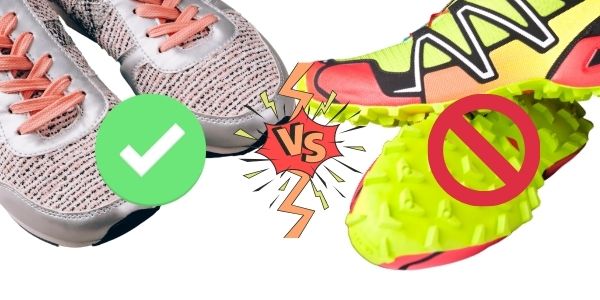
Trail and Running Shoe Durability
AD
A standard pair of running shoes can last up to a year, but it all depends on use and quality. Some high-quality more dense foam running shoes can last for several years. Others, six months when running regularly.
Trail runners are designed for running on dirt trails and rocks. Many people use trail runners for hiking. They can endure harsher conditions in general. Yet, each shoe brand has varying levels of outsole thickness and durability.
My Altra trail runners still feel good on my feet but their tread is worn down too much to be useful as a trail runner except on more level trails. I used them on the pavement as well, so this might be why they wore down so fast.
The hardness of the outsole varies. To get grippy rubber soles, the rubber usually needs to be fairly soft.
I believe that road running shoes and trail running shoes have about the same range of soft to hard outsoles on their shoes. I think it depends on the brand and how grippy a shoe needs to be to meet certain expectations.
The way to have your outsoles last longer is to buy ones where the tread is over 4mm tall.
Look for robust materials that make them durable against scrapes, scratches, and tears.
Not only this but look at reviews and find shoes that are known to last for a very long time. Some users have used their trail runners or road shoes for hundreds of miles, and they still have life in them.
Road running shoes aren’t nearly as durable in the upper. Their material is usually a mesh material. Their design favors lightweight materials and they aren’t as resistant to tearing or scratching. If used on the trail, they’ll need to be replaced a lot sooner than trail runners.
In general, trail running shoes are a bit more durable, and although that’s not always the case. I’m giving the win to trail running shoes.
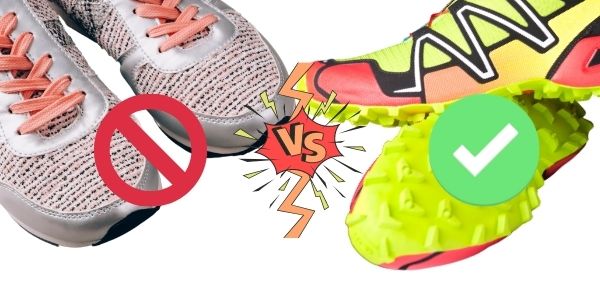
Trail and Running Shoe Protection From Injury
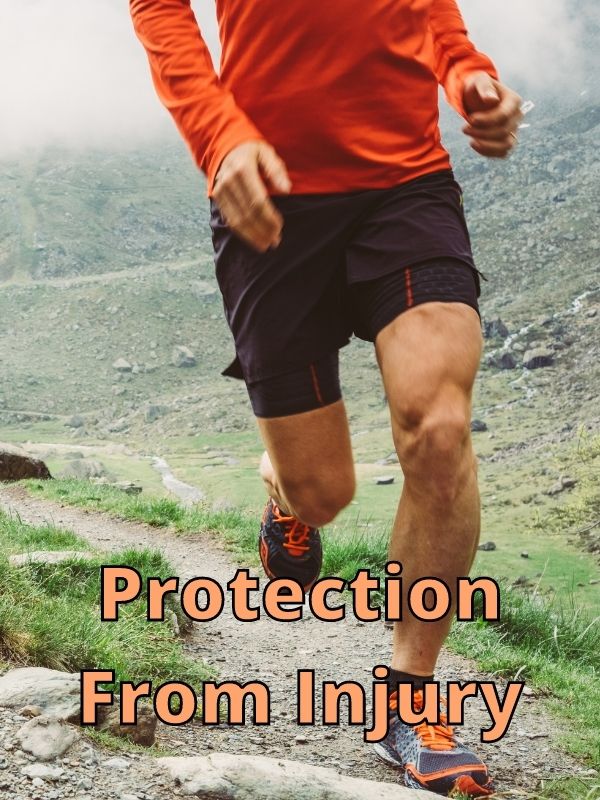
Trail runners and running shoes can both protect your feet from impacting the ground and stabilizing your foot when landing.
There are many variations of shoe types and each has benefits for different people and
Trail shoes are good at protecting runners from rough terrain that may hit shoes or push into the outsole. They often have a wide base that helps to stabilize the foot for better control as the foot lands and maneuvers.
Running shoes can also have wider bases to help with stabilization. They tend to have more cushion which helps reduce impacts during running.
Both trail and running shoes tend to have a rubber outsole for good grip.
All of these features help protect runners from injuries when running. Runners can avoid most injuries by running with care and not go beyond their abilities.
Runners can keep injuries at bay by having good quality running shoes for the environment they are running in. When they pace themselves and keep the length of their run within their ability, injuries can be reduced.
In general, both trail running shoes and road running shoes offer about the same protection from injury. The win goes to both types of shoes.
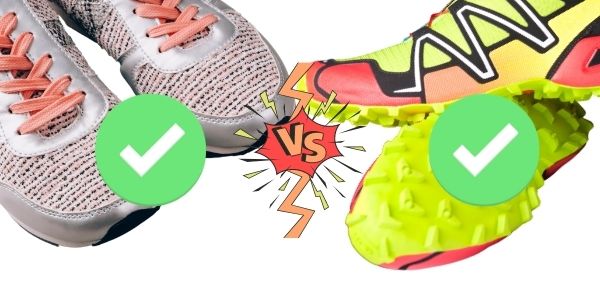
Trail and Running Shoe Warm Weather Versatility
AD
Because of their thick material, trail runners’ feet can feel stuffy in hot weather. Some may have waterproofing uppers that don’t breathe as well as road shoes.
Because of this, they are better suited for use from late autumn through winter, and up to early spring, as they can help keep your feet warm and sometimes dry in these conditions.
Because of their mesh-like, flexible material, road running shoes allow your feet to breathe, airing out the moisture, and preventing prevent your feet from getting too hot or stuffy.
The only downside is that they don’t offer much in terms of warmth. In cold climates, your feet can feel ice-cold, even with thick socks.
In general, road running shoes are a bit more comfortable in warm weather because they can breathe well. I’m giving the win to road running shoes.

Trail and Running Shoe Weight
AD
Many experienced road and trail runners know that weight matters a lot more when you’re in a race. So having lightweight shoes makes more sense for those who are trying to beat a certain time or go a long distance.
Running shoes are nearly always lighter than trail running shoes. Having said that, some lightweight trail runners do exist and offer durability and protection despite their weight.
It’s crucial to strike the right balance between weight and toughness, so your shoes don’t weigh you down, but are also suitable for the route and terrain you’ll be taking.
In general, road running shoes are lighter. This may not always true but it usually is. I’m giving the win to road running shoes.

Trail and Running Shoe Waterproofing
AD
Because they’re designed solely for outdoor use, trail runners tend to offer some waterproof protection. You’ll need to check the shoe you are interested in.
Some trail runners are fine in the summer and some are a bit better suited for cold weather.
Though road running shoes may offer some water protection, it often isn’t much. Simply stepping into a puddle or stream can cause your feet to get very wet. This makes them less suitable for rainy or snowy environments.
In general, trail runners are more waterproof. I’m giving the win to trail running shoes.

Trail and Running Shoe Breaking In
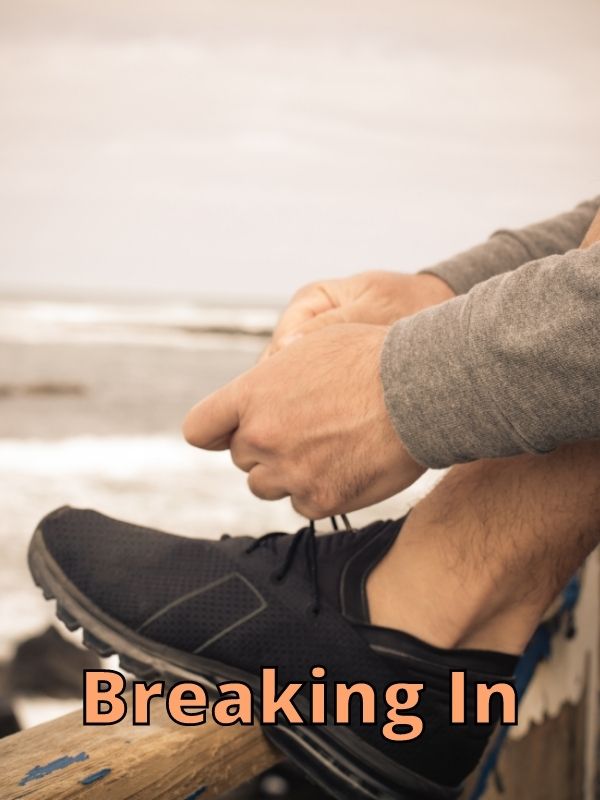
Because of their flexible, soft, and lightweight design, running shoes rarely need ‘breaking in’, as the material will automatically flex around the shape and size of your foot.
This means that new running shoes can often be put on straight away without causing any discomfort.
The same can be said about many trail running shoes, even though they may have a firmer midsole.
Many find that their trail runners are comfortable right out of the box. My opinion is that you should find a shoe that is comfortable when you first try it on.
Unless you are changing shoe styles, such as getting a zero drop shoe when you’ve never worn a shoe like that, you can probably find a shoe that is comfortable to run in right from the beginning.
Just be careful your not getting a hiking shoe that looks like a trail runner. Hiking shoes will have a solid plastic piece in the middle that isn’t flexible or fairly rigid foam and outsole.
In general, both trail running shoes and road running shoes should have little to no break in period. The win goes to both types of shoes.

When Should You Avoid Running Shoes?
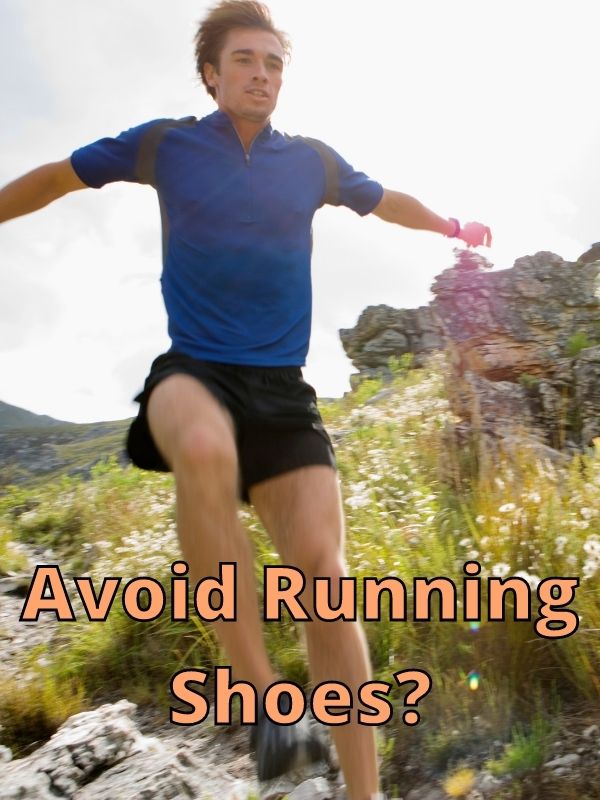
Running shoes can be used on a variety of casual hikes and trails, as their midsoles and outsoles can do well on light trails
Having said that, they’re not suitable for all environments. Hill climbing and going down steep declines on trails are better suited for more rugged trail shoes.
Trail shoes can often handle wet, rainy, muddy, or light snowy environments. Also, if the terrain of your journey is particularly uneven, craggy, or slipper, it’s probably best to go with trail runners.
In general, trail runners are better at hills and rugged environments. I’m giving the win to trail running shoes.

Final Thoughts
When choosing between running shoes or trail running shoes, the decision is entirely up to you. Take into account the terrain, weather, and environment of your running as well as how much you’ll be using that particular shoe on the street or trail.
Both have their distinct advantages, and both offer some sort of crossover. But for regular use, it might be best to get a pair of each, just so you know you’ve gotten all possibilities covered.
Thanks for visiting Helpshoe.com

